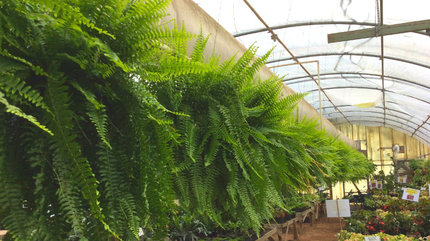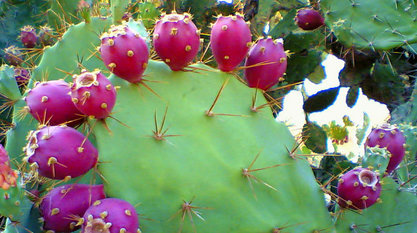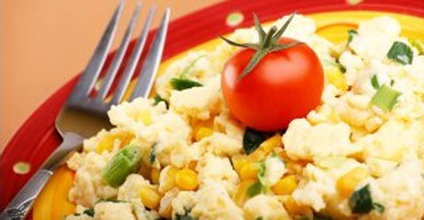The Prickly Pear: Easy to Grow,
Delicioso for Breakfast, and an
Effective Cure for a Hangover!
by Mick Vann
Researchers tell us that the prickly pear cactus was one of the
earliest food crops, with Mesoamericans cultivating Opuntia ficus-
indica more than 9,000 years ago.
Today in South Africa, the Maghreb, Sicily, and South, Central,
and North America the cactus is being grown as a food stuff, as
cattle feed, and for the intensely colored, flavorful fruit, known
in Mexico as tuna. The Mexican word for the prickly pear cactus,
nopales, is based on the ancient Nahuatl nohpalli.
Nopales are strips or cubes cut from the pads of prickly pear cactus;
114 different species grow in Mexico. They are sold as spineless,
peeled pads in Hispanic markets, and can be used raw or blanched
(too much cooking and they get mucilaginous, like slimy okra).
Bottled or canned versions packed in brine are available in His-
panic markets and some groceries. These should be rinsed in warm
and then cold water, and drained before use.
For fresh nopales, obtain tender young pads about 4 inches long
and ⅛ inch thick. Larger ones will be tough and have a papery
skin that must be removed before using. Remove all of the small
spines on the pads with the blade of a knife.
It is easiest to hold the pads with folded-over newspaper or tongs
to prevent getting stuck by the thorns while processing. Cook
briefly in boiling, salted water until just starting to get tender but
not slimy (see cooking method, below).
To prepare the fruit, lay a prickly pear on a cutting board and cut
almost in half lengthwise. Using a knife with a flexible blade,
“filet” the flesh from the skin as you rotate the blade around the
interior surface of the skin, much like you would a kiwi fruit.
You can easily grow prickly pear cactus in your yard, and many
ranchers in Texas consider the plant an invasive pest, but they
provide a valuable habitat for many critters (including snakes, so
use caution when harvesting). In times of extreme drought, ran-
chers burn the thorns off with propane torches as graze for their
livestock.
To grow your own, they require only good drainage and adequate
sun. Nurseries sell desirable spineless and ornamental varieties,
and varieties will soon hit the market that have been bred for larger,
sweeter fruit.
To grow the common local species you can just cut off a pad from
a plant, let the cut surface scab over for a few days, and insert it
into the ground. It will grow with a vengeance.
The flesh of the pads is used in salads, in pico de gallo and salsas,
with scrambled eggs, in tacos, with meats, and in other dishes. The
fruit has a texture similar to watermelon, kiwi, or dragonfruit, and
the sweet, tart flesh can be used in a similar fashion, or juiced and
added to drinks (local soda company Maine Root makes a prickly
pear fruit soda called “Pink Drink”).
Prickly pear fruit also makes a spectacular sorbet. Health freaks
will appreciate very high levels of Vitamin C, antioxidants, and
fiber, and studies suggest nopales could help with diabetes and
hangovers.
Huevos Revueltos con Nopales
Scrambled Eggs with Cactus Strips
Serves 1
The Northern states of Mexico are especially fond of nopales. The
blanched or grilled pads are fantastic mixed with scrambled eggs,
and then eaten as a breakfast platter, with beans, chile-dusted and
browned diced potato, and tortillas, or you can just place the filling
inside a hot flour tortilla for a classic Austex breakfast taco.
____________________________________________________
1 tablespoon lard, bacon fat, duck or chicken fat, or butter
1 large or 2 small scallions, trimmed and sliced
1 large serrano chile, stemmed and julienned (seeds and ribs re-
moved for less heat)
⅔ cup prepared nopales (see preparation method, below)
2 large eggs, scrambled
½ teaspoon salt
¼ teaspoon cracked black pepper
3 Tablespoons grated Chihuahua or Monterey jack cheese for garnish
Salsa of your choice, as a topping
____________________________________________________
In a seasoned or nonstick skillet over medium heat, add the lard.
When shimmering, add the scallion and chile and sauté for 3 mins.
Add the nopales and sauté 2 minutes. Add the eggs, salt, and pepper,
and using a heat resistant rubber spatula, scrape the eggs from the
outside-in, just until the eggs are fluffy and set, but still moist. Place
on a plate and garnish with the grated cheese, and top with your fav-
orite salsa.
____________________________________________________
Note
To prepare nopales: You can buy them brined in jars (which need
to be thoroughly rinsed), but they are much better fresh. Look for
prepped (thorns removed), firm paddles in the produce section of
gourmet, specialty, or Hispanic markets. If you harvest and prepare
them yourself, using tongs or gloves, take a paring knife and excise
each group of thorns by slicing just under the surface. When both
sides are cleaned of thorns, remove the outside edge, and cut into
¼ inch strips.
To blanch nopales:
1 ½ Tablespoons salt
Pinch of baking soda
1 clove garlic, smashed
1 ¼ pounds of nopal strips
In 4 quarts of boiling water over high heat, add the salt, baking
soda, and garlic, stir well, and then add the cactus strips. Skim
off any foam that rises to the surface, and cook until just starting
to get tender, but not limp (about 8 to 12 minutes, depending on
freshness). Pour into a colander and rinse thoroughly with cold
water to stop the cooking process and rinse off any slime. Drain
well and reserve.
Alternatively, prepare the pads as before and grill both sides over
a burner or coals until the pad starts charring, turning yellowish,
and starts to get tender. In case you weren’t paying attention and
got pierced with tiny thorns, take a piece of duct tape and lightly
drag it across the skin, or put a dab of Elmer’s Glue on the thorns.
When the glue dries peel it and the thorns from your skin.
____________________________________________________
Mick Vann is a writer, horticulturist and chef extraordinaire. You
can read Mick's musings on food and life at his blog: Gustidude






